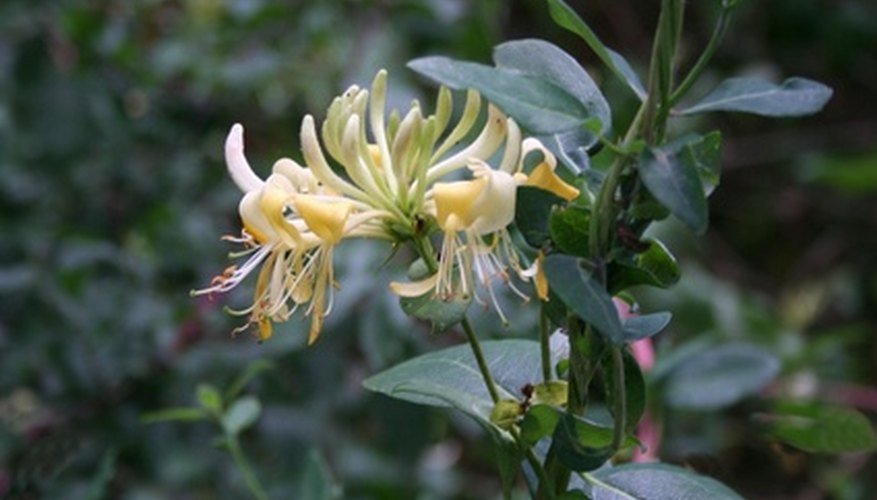Available as vining plants and bush types, honeysuckle (Lonicera) has few diseases and pests, according to the Missouri Botanical Garden. However, every type of plant encounters problems particular to its species. Proper care and conditions help honeysuckle varieties fend off the common afflictions to which they are susceptible.
Powdery Mildew
A common fungal problem for honeysuckle, powdery mildew appears as an unsightly, white film on the leaves, stems and flowers. Rainy, humid weather and poor air circulation exacerbate the condition. According to the Purdue Plant Diagnostic Laboratory, powdery mildew is rarely fatal to the plant. Using fungicides can protect healthy foliage from contracting the disease and transplanting honeysuckle where the plant won't be overcrowded can help. Avoid getting the leaves wet and remove any infected parts. Clean up any dropped leaves during fall cleanup.
- A common fungal problem for honeysuckle, powdery mildew appears as an unsightly, white film on the leaves, stems and flowers.
- Using fungicides can protect healthy foliage from contracting the disease and transplanting honeysuckle where the plant won't be overcrowded can help.
Leaf Blight
Leaf blight is a disfiguring fungal disease. Young leaves become twisted and turn from yellow to brown. Severe infection causes the leaves to drop, but the stems of the plant remain healthy. The University of Nebraska recommends using the fungicide mancozeb, especially during wet weather. Be sure to follow directions on the label. Remove and destroy the infected leaves.
- Leaf blight is a disfiguring fungal disease.
- Severe infection causes the leaves to drop, but the stems of the plant remain healthy.
Crown Gall
Crown gall is a bacterial infection that causes galls or swollen areas to occur on the stem close to the ground, giving the plant a deformed shape. According to the Connecticut Agriculture Experiment Station, the bacteria attack through a perforation in plant tissue. Treatment is limited to destroying affected plants. Avoid damaging healthy plants by careful handling.
- Crown gall is a bacterial infection that causes galls or swollen areas to occur on the stem close to the ground, giving the plant a deformed shape.
Aphids
Aphids infest honeysuckle leaves and stems, causing an unsightly appearance and damage to the plant. Wash the plant with water in the morning. Treat with horticultural oil or insecticidal soap at intervals listed on the label. Follow all directions carefully.
- Aphids infest honeysuckle leaves and stems, causing an unsightly appearance and damage to the plant.
- Treat with horticultural oil or insecticidal soap at intervals listed on the label.
Invasiveness
Although extremely fragrant, the Japanese honeysuckle (Lonicera japonica var. Halliana) causes problems with its invasive nature, choking out other vines and native plants. The Missouri Botanical Garden warns that this variety should not be planted in the Midwest. Plant the non-invasive honeysuckle (Lonicera flava) instead.
- Although extremely fragrant, the Japanese honeysuckle (Lonicera japonica var.
- Plant the non-invasive honeysuckle (Lonicera flava) instead.
Poor Growth
Helen Yemm of Telegraph advises circumventing spindly, non-flowering honeysuckle by planting it in the conditions it prefers. Hot, sunny areas near walls that leach lime do not produce a healthy appearance. Instead, mulch with leaves around the crown of the plant to keep it cool or plant it in a cooler area while providing full sun.
